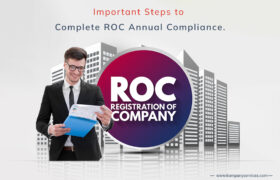One type of corporate structure that was developed and incorporated in accordance with the Companies Act of 2013 is the private limited company. Under the provisions of Section 2 of the Act, a Private Limited Company is defined as a company that restricts the rights to transfer its shares and places a limit of 200 members on the total number of members. Let’s make this definition a little easier to understand.
Corporations that are known as private limited companies are structures that are owned jointly by a number of shareholders who each control a portion of the company’s shares. However, there are limitations placed on the transfer of these shares. It is not possible for the shares of a private company to be available for free and public trading on stock exchange platforms.
A further point to consider is that members of the general public are not permitted to own shares in a private limited company. As we move on to the second portion of the definition, a Private Limited Company is restricted to having a maximum of two hundred shareholders. According to this, it is not possible for it to have more than 200 shareholders at any given time. On the other hand, the bare minimum of their numbers is only two.
What are the benefits associated with registering a private limited company in India?
- Limited liability for personal assets: The shareholders of a private limited company are guardians of their personal assets. This means that your liability as a shareholder will be limited to the extent of your contribution to the company’s liability. Since the shareholders have no personal liability, they are not obligated to contribute any of their own assets to cover the company’s liabilities.
- Legal Entity: A private limited company operates as an independent legal entity, distinct from its shareholders and directors. This signifies that the management of the company’s assets and liabilities, debtors and creditors, falls under its purview. The shareholders shall not bear liability for the company’s losses. Therefore, the creditors are precluded from initiating legal proceedings against the directors or shareholders in order to retrieve the funds.
- Capital Raising: Despite the compliance obligations associated with registering a private limited company, entrepreneurs prefer this structure because it enables them to expand, raise funds through equity, and limit liability.
- Credibility: In accordance with the Companies Act 2013, corporations in India are duly registered with the Registrar of Companies (ROC). The information regarding the organization is accessible to the public via the Ministry of Corporate Affairs (MCA) portal. Additionally, an inventory of all the directors is furnished during the company’s formation process. As a result, a private limited company is a more reliable business structure.
- Sustained Existence: Until it is formally dissolved, a corporation maintains life or operation in perpetuity through “perpetual succession.” As an independent legal entity, a corporation remains operational despite membership modifications or terminations, unaffected by the demise or cessation of any representative.
In India, the process of registering a company is broken down into several steps.
The members or promoters of a Private Limited Company are required to meet some minimal conditions in order to initiate the formation of the company. These requirements include the number of shareholders, directors, name, and registration address. It is the responsibility of the promoters to ensure that the company is formally formed by the Registrar of Companies once all of the conditions have been satisfied. A step-by-step guidance to this application-based approach is provided below. This technique is described in more detail below. It is important to follow the guidance in order to finish the documentation and process of registering a corporation.
First Step: Obtain the DIN and DSC of the Promoters
A Director Identification Number, often known as a DIN, is required to be in possession of each and every director of a Private Limited business before the process of business registration may commence. The MCA website provides applicants with the opportunity to submit a form called DIR-3 along with supporting papers such as a photograph, a proof of address, and a personal identification number. Additionally, in order to validate the online application for company registration, the authorised director needs to possess a Digital Signature of Class 3 classification.
Step 2: Choose and Reserve the Name of the Company
You cannot just pick a word at random to use as the name of your organisation. In order for your clients to recognise it effectively, it must be representative of both your brand and the activities of your firm. In addition, the name must be in accordance with the rules established by the MCA, and it must not be identical to or similar to the name of an existing company, limited liability partnership (LLP), or registered brand. Before you register your business, you can come to us to verify that the name you have chosen for your firm is legal. Get the ROC to approve and reserve the name of your firm once you have determined that it is a legitimate name for your business.
In order to secure the name of the company, an application must be submitted in SPICE Plus PART. It is possible to submit a form to the ROC. There is a fixed government cost of Rs. 1,000, and the applicant has the ability to suggest two names for each application. After conducting an exhaustive review of the names that have been suggested, the ROC is going to reserve the name that is both legitimate and available for the company. After a name reservation has been made, the business will be sent a Name Approval Letter that is only valid for the following twenty days. The applicant is responsible for ensuring that the procedure of registering the company is finished within the allotted time during which it is valid.
Step 3: Draught MOA & AOA
The Memorandum of Association (MOA) and the Articles of Association (AOA) of the Company are two essential legal papers that must be submitted to the ROC in order to be registered. All of the shareholders are required to sign these documents in the presence of a public notary, and they must be written on stamp paper of an appropriate value. Afterwards, the Notary will affix a stamp to the documents, which will need further payment of stamp duty and notary fees. The company’s charter, which is also known as the MOA, is where the fundamental legal information is stored. On the other side, the AOA is where the norms and regulations with regard to internal management are documented.
Step 4: Save the Application for SPICE Plus
The web-based application known as INC-32, sometimes known as SPICE Plus, is filed for the purpose of business formation in India. It is broken up into two parts: PART A and PART B. Part A is the document that is submitted in order to obtain approval for the name of a company. On the other hand, PART B is an integrated application that is utilised for the incorporation of companies. To get your business registered with the ROC, you can get it registered by filling out this form and submitting it on the website of the MCA.
Step 5: Obtain a Certificate of Registration for the Company
An examination of the SPICE Plus application, including all of the required documents and fees, is carried out by the ROC. Following the completion of the thorough verification of all the information, the ROC will move forward with the process of registering the company. During this process, the firm is registered, and a Certificate of Registration is issued in its current name. The CIN, also known as the Corporate Identification Number, serves as the exclusive identifier of the firm and is included in the Certificate of Registration itself. In addition, the Company is provided with a PAN and TAN in its name, in addition to the Certificate.
In order to successfully complete the process of registering a private limited company in India, it is necessary to have a comprehensive understanding of all of the topics that are discussed in this blog. Having their comprehensive knowledge guarantees that the process of forming a business will be simple, uncomplicated, and devoid of any complications for you. This includes the processes of registration, as well as the documents, fees, and post-registration compliances. It is my hope that this site will provide you with all of the knowledge that you require concerning the same. In the event that you still have questions, you can get in touch with us to receive a free consultation, or you can express your inquiries in the comments area.




